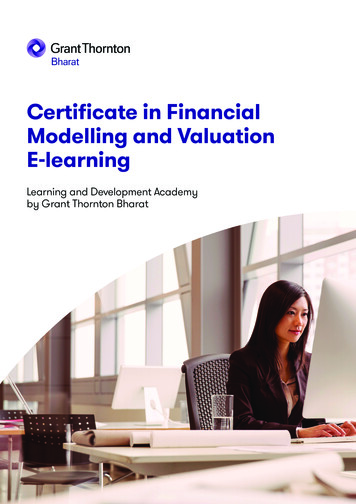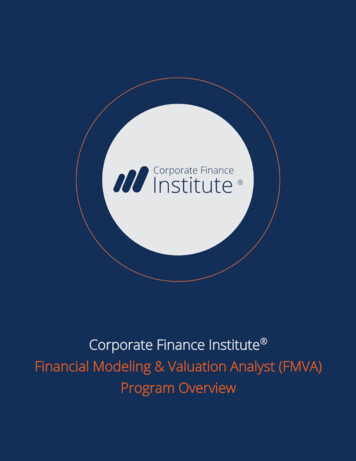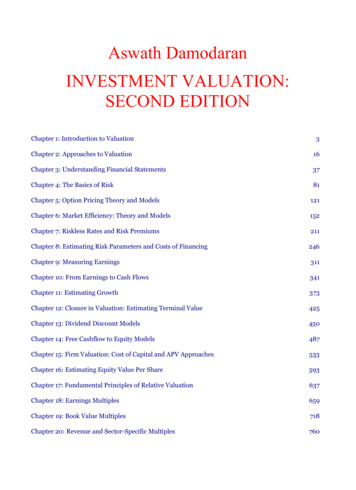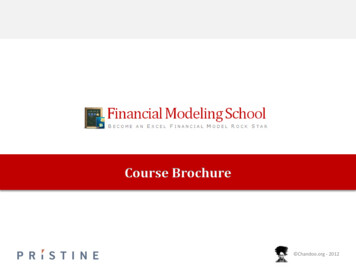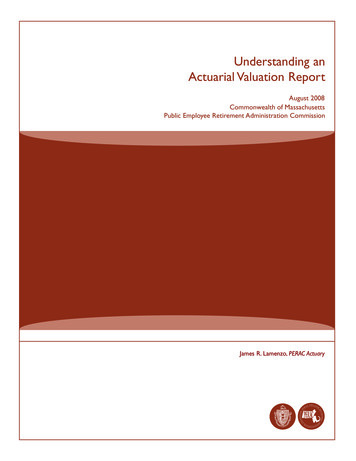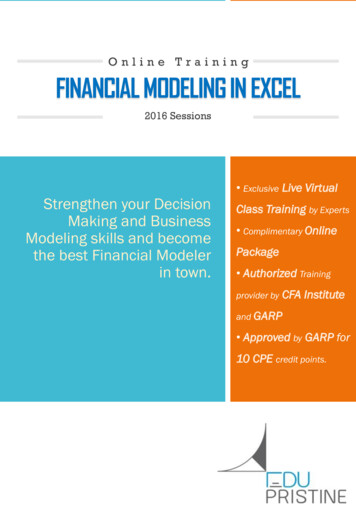
Transcription
FINANCIAL MODELING & VALUATIONCUSTOMIZED TRAINING PROGRAMSDETAILED COURSE DESCRIPTIONS 1 (212) 537-6631 1 (212) 656-1221 (fax)info@wallst.training
ABOUT WALL STREET TRAINING & ADVISORY, INC.WHY CHOOSE WSTWe analyzed the current learning process in finance and Wall Street, figured out how teaching and trainingshould be done and then implemented our learning processes. In short, our strengths that separate us fromour competitors include: Hands-on, interactive, practical, non-theoretical, no "b.s." approachTraining modules replicate exactly how it is done on Wall StreetBlend of real-world and effective teaching style that is more down to earth and at the audience’s levelFast-paced learning where the goal is for participants to become experts and extremely quick and efficientso they could spend more time on analysis of the numbers rather than pure number crunchingLearn how to completely avoid using the mouse when building financial modelsAbility to translate difficult and advanced concepts into plain English while providing highly detailedexplanations and intricacies; ability to integrate a variety of disparate topics into one focused themeTeach nuances and real-life intricacies, not just the basic how-to; we teach the rules and the exceptions!Models that are built more cleanly, more efficiently and are meant to be self-contained reference modelsHighly interactive, dynamic teaching approach – we guarantee you will learn AND have fun! Wall Street Training & Advisory, Inc.Hamilton Lin, CFAFounder & CEO2 1 (212) 537-6631info@wallst.trainingwallst.training
ABOUT WST SELF-STUDYWST’s Self-Study was formed with the goal of: Helping people obtain, advance and achieve their career aspirations Supplying the tools, skills, knowledge and ability to succeed on Wall Street Replicating the live learning environment to learn at your own pace and time, location-independent Providing a more efficient way to disseminate knowledge to empower professionals with required skills Improving self-study – alternatives are text & paper-based; who wants to read 400 pages? Elevating standards and promoting best practices and efficiencies on Wall StreetWST SELF-STUDY VIDEO LEARNING PLATFORMOur fully-integrated, video-based learning platform is a content & learning management system customdesigned for Wall Street financial modeling needs. It was developed to deliver state-of-the-art video &interactive assets to your organization. It is extremely robust and provides: Same materials used for training investment banks, research departments and asset managers Dynamic, instructional, streaming videos of the entire financial analyst program Interactive and engaging side-by-side learning with instructor and video Excel templates & models, presentation and slide materials and supporting content and exhibitsWHO CAN BENEFIT Current finance professionals looking to advance careerProfessionals looking to career transition into financeAnyone with an interest in finance and looking to learn analysisCollege or business school studentsCorporations and employeesOur courses set the standard in the following finance areas: Investment banking (bulge bracket and boutiques) Mergers & Acquisitions (buy and sell-side) Securities Research (equity & fixed income) Asset and Investment Management Credit Analysis (corporate & commercial banking) LBO Modeling (private equity & high yield)WHY CHOOSE WST SELF-STUDY Robust Learning Platform: text- and slide-based alternatives simply don't compare Superior Content: we teach the nuances and real-life intricacies, not just the basic how-to Superior Instruction: we tie together random disparate pieces of knowledge and translate difficult andadvanced concepts into plain English while providing highly detailed explanations and intricacies Ease of Use: our content is interactive, fun, engaging, easy to follow and is not boring Wall Street Training & Advisory, Inc.Hamilton Lin, CFAFounder & CEO3 1 (212) 537-6631info@wallst.trainingwallst.training
WST COURSE TOPICSWST offers a wide variety of topics ranging from Basic to Advanced levels. Our courses are designed forparticipants with various backgrounds, from students and entry-level professionals to professionals withsome work experience and professionals in the midst of a career transition. Additional courses are availableand can be customized to fit your needs. We are flexible in designing & customizing a program structurethat works for you.We begin with the basic & fundamental topics to core financial modeling & valuation topics to theextremely complex, super-advanced financial modeling courses. We highly recommend that you beginwith our Basic & Fundamental courses which you must master before proceeding to the core modeling andadvanced modeling topics. Our Excel-based courses are extremely keyboard and shortcut oriented to speedup number crunching to allow more time for proper qualitative analysis and interpretation of quantitativeresults.THE APPETIZERSAccounting & Financial Statement Intensive BootcampOur in-depth crash course in accounting helps you learn and master a subject that is critical to the start ofyour finance career. This is oriented towards finance professionals as opposed to future accountants andas such, the focus is on analysis, proper interpretation and manipulation of accounting numbers to getcloser to economics of what’s transpiring. Throw the debits & credits out the door – we take a non-textbookand non-academic approach: we have two versions of our Accounting Bootcamp: one focused onimmersion in financial statements and borderline “forensic accounting” and another geared towards M&Ainvestment bankers.PACKAGE 1: Basic & Fundamental ConceptsOur basic concepts will allow you to learn and gain the fundamental knowledge that you must masterbefore the advanced content. We answer all the rarely answered "WHY" questions - "why do we do this, whydo we do that" - instead of answering: "well, just because" or "that's the way it's always been done", weactually clearly and easily explain the logic of why and how not just the what. Whether you are aneconomics or liberal arts major or a business/finance major looking to summarize the critical 30 pages inthat 400 page textbook, our Basic & Fundamental course modules will quickly set the proper foundation foryou to excel.PACKAGE 2: Core Fundamental ConceptsOur core fundamental concepts in finance involve the basic financial modeling and valuation techniquesthat introduce model building best practices as well as getting used to working efficiently in Excel. Afterunderstanding the basic fundamental concepts, the most important building blocks of modeling areintroduced as we begin to thoroughly analyze financial statements and their implications. Weintroduce the underpinnings of fundamental valuation (i.e. DCF analysis) and relative valuation (comps& multiples). Wall Street Training & Advisory, Inc.Hamilton Lin, CFAFounder & CEO4 1 (212) 537-6631info@wallst.trainingwallst.training
MAIN COURSEPACKAGE 3: Advanced Financial ModelingTake everything to the next level as we build upon the basic & core concepts to cover the fundamentalfinancial modeling concepts that one must be master in order to perform the minimum financial analysisrequired. We will make you "super-stars" in Excel and modeling techniques by plowing deep into buildingrobust, integrated models and properly analyzing the results of our models.PACKAGE 4: Valuation ModelingWe dive deeper into the nuances of valuation by understanding the art (not science) of valuation. Buildupon your core financial models by integrating and layering on hands-on valuation analysis. Constructstandard full-blown DCF analysis, trading & deal comps analysis and summary football field. Dive realdeep into the nuances of valuation by ripping apart footnotes and making subjective inputs whilebalancing objectivity.PACKAGE 5: Merger Modeling TopicsOur merger modeling topics introduce critical skills required for understanding how to structure andanalyze mergers & acquisitions. After modeling a company’s profits / cash flow and valuing the entity, onemust decide what to do with the company in the grand scheme of its strategic alternatives, including amerger or acquisition. We introduce the basics of deal structuring and implications on accretion/dilutionto building more involved merger models with the complexity of complicated FASB and IFRS accountingrules.PACKAGE 6: Leveraged Buyout (LBO) TopicsOur LBO modeling courses introduce critical skills required for properly understanding and quantifyingcapital structure changes from simple share repurchases to the extreme of a leveraged buyout. Thetechniques and concepts learned in building proper, robust, dynamic and flexible LBO models are highlyvalued given the relatively difficult nature of setting up, quantifying and articulating the complexrelationships and intricacies of the LBO. We clearly convey the complexities involved in understandingthe deal structure, sources & uses, refinancing options, credit ratios and the all-important debt sweep.DESSERT & DRINKSTECHNICAL APPLICATIONS: Excel and moreA financial analyst won’t be spending all their time on Excel building financial models, but will be crunchinga fair amount of data and creating charts, tables & presentations. From due diligence of analyzingsalary rosters and client lists to industry analysis and reports to creating charts and graphs, you will live andbreathe Excel, Word & PowerPoint and we will teach you all the best practices of the most importanttools.OVERVIEW OF FINANCIAL MARKETS EXHIBITSIn our Overview of Financial Markets, we introduce the major jargon and terminology in finance, from thesell-side to the buy-side and capital markets, from investment banking to sales & trading and research andasset management. In addition, we quantify and dig deep into specific selected topics of interest fromthe long-term relationship of depreciation and capital expenditures to share repurchase impacts, to causeof circular references in financial models and much more! Wall Street Training & Advisory, Inc.Hamilton Lin, CFAFounder & CEO5 1 (212) 537-6631info@wallst.trainingwallst.training
SECOND ROUNDS!Private Company ValuationEvaluation of middle market and private companies with sparse publicly available data take a completelydifferent approach than those of publicly traded companies. Usually, analysis of private companiesrequires a different approach to modeling than public entities. Instead of focusing just on corporatefinance, a deeper more thorough understanding of the private company’s operations is required.Super-Complex M&A LBO ModelingTake your modeling skills to an unmatched level: build full-blown, fully-integrated, merger & LBO modelsthat slap together the complete target acquiror model into the extremely robust merger model. Theintegrated full-blown LBO model allows the target to be acquired or LBO’ed. This is among the mostadvanced models out there. Period. End of story.INDUSTRY SPECIFIC MODELINGDistressed Financial ModelingNormally, our financial modeling & valuation courses are always prefaced with a caveat: “applies to run-rate,going concern entities, not distressed or restructuring” companies. Why? It’s simple - the rules ofengagement are completely different for distressed entities that have financial or operationaldifficulties. Our distressed series will teach you how to model and value distressed companies andsecurities undergoing restructuring or the bankruptcy process.Bank Financial ModelingBanks, similar to insurance companies, play by a different set of accounting rules in which the normalapproach of building financial models don’t apply (such as revenue growth, COGS and SG&A, % ofrevenue, BS and days outstanding working capital). When it comes to balance sheet based companies, it’s awhole other world out there, so strap in and get ready! But don’t worry, we’ll take it easy with a detailedcommercial bank industry primer and overview to familiarize ourselves with the new terminology andthen tee you up methodically before diving into the complex stuff.Insurance Financial ModelingInsurance companies, similar to banks, play by a different set of accounting rules in which the normalapproach of building financial models don’t apply (such as revenue growth, COGS and SG&A, % ofrevenue, BS and days outstanding working capital). When it comes to balance sheet based companies, it’s awhole other world out there, so strap in and get ready! But don’t worry, we’ll take it easy with a detailedinsurance industry primer and overview to familiarize ourselves with the new terminology and then teeyou up methodically before diving into the complex stuff.Oil & Gas Industry Financial Modeling & ValuationThe energy industry impacts everyone in one way or another, from commuters to bottled water consumers.Oil and natural gas are the world’s leading energy supply, with gas stations in every neighborhood fuelingcars and trucks that travel millions of miles a day. In our oil & gas industry-specific courses, we cover boththe integrated oil & gas players and its subsectors (upstream: exploration & production; downstream:refining & marketing; midstream: logistics and transportation) as well as the oil & gas services andequipment ecosystem. Wall Street Training & Advisory, Inc.Hamilton Lin, CFAFounder & CEO6 1 (212) 537-6631info@wallst.trainingwallst.training
INDUSTRY SPECIFIC MODELING (cont.)Real Estate Development ModelingReal estate takes a different twist from traditional companies in that it doesn’t sell or produce anygoods. As such, the process of building up the P&L requires a different logic. From quantifying the costs ofa development project to the revenue build-up, we explore a master plan for community and condodevelopment to a commercial hotel project.REIT ModelingReal Estate Investment Trusts take a different life of their own by aggregating all the real estateinvestments and development projects the REIT manages and owns. The individual line items per propertyare not as relevant as everything in totality on a corporate basis. The goal is quantifying construction-inprogress, acquisitions and new development starts on the overall REIT financial statements.CREDIT, PORTFOLIO & RISK MANAGEMENTCredit & Risk AnalysisTangential to financial modeling and valuation is credit analysis. We take the typical dry boring credittraining and tweak it with perspectives from the buy-side credit point of view. This allows for a muchbroader and yet, simultaneously deeper, discussion and understanding of credit, a hard task to pull, but wethink we’ve done it. As if that weren’t enough, we think we’ve also been able to nicely blend hard corequantitative and statistics based concepts into our suite of portfolio and risk management courses.Portfolio & Risk ManagementOur suite of portfolio and risk management courses takes a quantitative approach to managingdiversification strategies and hedging strategies in the portfolio context. Understanding the impact ofmarket factors and Monte Carlo simulations will allow you to better sensitize and quantify risk factors onyour portfolio. Our Technical Trading course explains how to perfect your timing after your trade decisionhas been made. Once again, understand how the “boring” statistics concepts are actually used in the realworld for hedging, speculation and risk management. Wall Street Training & Advisory, Inc.Hamilton Lin, CFAFounder & CEO7 1 (212) 537-6631info@wallst.trainingwallst.training
BUY-SIDE, LEGAL AND SOFT SKILLSBuy-Side SeriesOftentimes, the results of your quantitative, fundamental and relative valuation provides an answer anddecision rule, but results in a different (and opposite) action item than the buy-side analyst. Getintroduced to the psyche of a hedge fund and learn how to think like a buy-side analyst. If you’re a buyside professional, you must master these fundamentals. If you’re a sell-side professional, adoption of thesetechniques will increase the value of the presenter’s ideas and result in increased and stronger buy-siderelationships.Banker’s Law & Soft SkillsUnfortunately for the hard-core number-crunching banker, it’s not all fun and games with financial modelingon the job. An important part of banking and finance is the legal aspects of a transaction beginning with the“baby-contract”, the NDA, understanding and hand-holding the due diligence process and wrapping up withpurchase agreements. After all, bonuses don’t get paid until the deal closes! Furthermore, while WSTfocuses on hard, technical skills training, the inevitable soft skills creep in, such as “executive presence” (orlack of, for those that need it). An additional important skill is learning how to properly craft informationmemorandums and research reports with specific techniques and style to make your point more impactful,thbeyond the annoying 8 grade grammar lessons.Note:The stated times on the following pages are approximate. Classroom duration refers to approximateduration of that course module taught in a live, on-site setting. If there is an online equivalent of a coursemodule, duration information will be listed under the “Online Version” columns. Total time video length additional interactive tools and setup time. In reality, one can expect to review the videos at least twice toproperly absorb all the material. The courses with an “N/A” in the Video Length and Total Time columnsindicate that online, streaming video option is not yet currently available. Wall Street Training & Advisory, Inc.Hamilton Lin, CFAFounder & CEO8 1 (212) 537-6631info@wallst.trainingwallst.training
WST COURSE TOPICS – CORE MODULESClassroomDurationCourse ModuleOnline VersionVideoTotalACCOUNTING BOOTCAMP3 days 11 hours 16 hoursAccounting & Financial Statements Intensive Bootcamp3 days11 hours16 hoursIntensive Accounting for Investment Bankers5 daysN/AN/A2 ½ days 9 hours 13 hoursAccounting & Financial Statements Integration½ day2.5 hours4 hoursHow to Analyze a 10K½ day2 hours3 hoursFinance 101 – Introduction to Finance½ day1.5 hours2 hoursCompany Profiles½ day1 hour1.5 hoursCompany Overview½ day1.5 hours2 hoursPACKAGE 2: CORE FUNDAMENTAL CONCEPTS2 days 7 hours 9 hoursCorporate Valuation Methodologies & Corporate Finance½ day2 hours2.5 hoursBasic Financial Modeling DCF Modeling1 day4 hours5 hoursBasic Valuation Techniques½ day1 hour1.5 hoursPACKAGE 3: ADVANCED FINANCIAL MODELING4 days 14 hours 18 hoursAdvanced Financial Modeling – Core Model1 day3.5 hours5 hoursEnhancements to the Core Model – Part 11 day3 hours4 hoursEnhancements to the Core Model – Part 21 day3 hours4 hoursSegment Build-up, Channel Checks, Drivers of Growth andSensitivity Modeling1 day4 hours5 hoursPACKAGE 4: VALUATION MODELING TOPICS4 days 10 hours 15 hoursCorporate Valuation Methodologies & Corporate Finance½ day2 hours2.5 hoursQuick & Dirty Trading Comps¼ day1 hour1.5 hoursRelative Valuation – Football Field¼ day0.5 hour1 hourComplex Trading Comps Analysis2 days4.5 hours7 hoursDeal Comps Analysis (Precedent Transactions)1 day1.5 hours2 hours2 days 6 hours 9 hoursM&A Deal Structuring½ – 1 day2 hours2.5 hoursMerger Modeling Basics½ – 1 day1.5 hours2.5 hoursIntermediate / Advanced Merger Modeling1 day2.5 hours4 hoursPACKAGE 6: LEVERAGED BUYOUT (LBO) TOPICS2 days 5 hours 7 hoursLeveraged Buyout Overview¼ day1 hour1.5 hoursQuick & Dirty Basic LBO Modeling½ day1 hour1.5 hoursAdvanced LBO Modeling1 day2.5 hours4 hoursOVERVIEW OF FINANCIAL MARKETS EXHIBITS½ day 2 hours 3 hours23 days 64 hours 90 hoursPACKAGE 1: BASIC & FUNDAMENTAL CONCEPTSPACKAGE 5: MERGER MODELING TOPICSTOTAL DURATION – CORE MODULES Wall Street Training & Advisory, Inc.Hamilton Lin, CFAFounder & CEO9 1 (212) 537-6631info@wallst.trainingwallst.training
WST COURSE TOPICS – ADVANCED & INDUSTRY MODULESClassroomDurationCourse ModuleOnline VersionVideoTotalPRIVATE COMPANY VALUATION4 days 10 hours 13 hoursPrivate Company Valuation1 day3 hours4 hoursSegment Build-up & Sensitivity Modeling1 day4 hours5 hoursPrivate Company Pro Forma Modeling½ day1.5 hours2.5 hoursM&A Earnout Modeling½ day1 hours1.5 hoursVC Investing: Participating Preferred Securities Waterfall1 dayNANASUPER-COMPLEX M&A LBO MODELING4 – 6 days 14 hours 20 hoursComplex, Super-Advanced Merger Modeling2 – 3 days5 hours10 hoursComplex LBO Modeling & LBO Model Enhancements2 – 3 days8.5 hours10 hoursDISTRESSED MODELING1 day 6 hours 9 hoursDistressed Investing Overview & Financial Modeling1 day6 hours9 hoursBANK FINANCIAL MODELING5 days 12 hours 19 hoursBank Industry Primer½ day2.5 hours4 hoursBasic Bank Financial Modeling½ day2 hours3 hoursIntermediate Bank Financial Modeling1 day2 hours3 hoursAdvanced Bank Financial Modeling3 days5 hours9 hoursINSURANCE FINANCIAL MODELING4 days 9 hours 16 hoursInsurance Industry Primer½ day2.5 hours4 hoursBasic Insurance Company Financial Modeling½ day1.5 hours3 hoursAdvanced Insurance Company Financial Modeling3 days5 hours9 hoursOIL & GAS FINANCIAL MODELING & VALUATION5 – 6 daysN/AN/AOil & Gas Services Industry Primer & Financial Modeling1 – 2 daysN/AN/AIntegrated Oil & Gas Industry: Basic Financial Modeling1 dayN/AN/AIntegrated Oil & Gas Industry: Financial Modeling & Valuation3 daysN/AN/AREAL ESTATE DEVELOPMENT & REIT MODELING3 days 4 hours 5 hoursReal Estate Development – Introduction (Master Plan Hotel)1 day3.5 hours5 hoursMulti-DayN/AN/AREIT Modeling2 daysN/AN/ABUY-SIDE SERIES½ day 2 hours 3 hoursHedge Fund – Mechanics & Applications of Long/Short HF½ day2 hours3 hoursTECHNICAL APPLICATIONS – EXCEL3 days 11 hours 16 hoursExcel Fundamentals for the Finance Professional1 day3 hours5 hours1 – 2 days3.5 hours5 hoursExcel Charting & Graphing Techniques & PowerPoint Integration1 day3.5 hours5 hoursVBA for Excel (Visual Basic for Applications in Excel)2 daysN/AN/AAdvanced Property Development (Condos, Office, Mall, Hotels)Advanced Excel for Data Analysis Wall Street Training & Advisory, Inc.Hamilton Lin, CFAFounder & CEO10 1 (212) 537-6631info@wallst.trainingwallst.training
WST COURSE TOPICS – CREDIT, PORTFOLIO & RISK MANAGEMENT AND MOREClassroomDurationCourse ModuleOnline VersionVideoTotalCREDIT & RISK ANALYSIS TRAINING9 daysN/AN/ACredit and Risk Analysis Training3 daysN/AN/ACase Study and Credit Memo1 dayN/AN/ACredit Agreements and Covenants Analysis1 dayN/AN/A13-Week Cash Flow Modeling2 daysN/AN/ARecapitalization Modeling2 daysN/AN/APORTFOLIO & RISK MANAGEMENT9 daysN/AN/AGlobal Macroeconomics (and Implications on Rates)1 dayN/AN/ACredit Risk Modeling in Excel & VBA: Default Risk & Prepayments2 daysN/AN/AValue at Risk (VaR) Modeling for Different Asset Classes in Excel2 daysN/AN/APortfolio Optimization & Efficient Frontier Modeling2 daysN/AN/ABank Capital Adequacy Modeling and Basel III Compliance1 dayN/AN/ATechnical Analysis & Trading1 dayN/AN/APORTFOLIO & RISK MANAGEMENT (PRODUCTS)14 daysN/AN/ACredit Derivatives Modeling in Excel & VBA2 daysN/AN/AVolatility/Correlation Modeling and Risk Management2 daysN/AN/AFixed Income Modeling and Risk Management2 daysN/AN/AInterest Rate Derivatives Modeling and Term Structure of Rates2 daysN/AN/AForeign Exchange (FX) Modeling & Hedging2 daysN/AN/AIntroduction to Options: Greeks & Option Strategies1 dayN/AN/AComplex and Exotic Option Pricing Models & Simulation in Excel & VBA2 daysN/AN/ALEGAL & SOFT SKILLS3 daysN/AN/ABanker’s Law: Legal Aspects of Transactions (NDA, Due Diligence, SPA)1 dayN/AN/ASoft Skills: Executive Presence1 dayN/AN/ASoft Skills: Research Report Writing1 dayN/AN/ATOPICAL SUBJECTS5 daysN/AN/A½ – 1 dayN/AN/A2 daysN/AN/A1½ daysN/AN/APension & OPEB Accounting & AnalysisOverview of Financial Markets & Capital Markets / Securities MarketsIntroduction to Economics (Macro, Micro and Global) Wall Street Training & Advisory, Inc.Hamilton Lin, CFAFounder & CEO11 1 (212) 537-6631info@wallst.trainingwallst.training
WST CURRICULUM TRACKS/SPECIALIZATIONSOur financial modeling course modules will help those who want to propel to the top of their field andindustry by sharpening and honing specific technical skills. Our courses are thorough and comprehensive tohelp you achieve your goals, regardless of your specialty within fundamental tressedTechnicalAnalysis &OptionsRisk &PortfolioMgmtInv.Banking Basic &AdvResearch& HF Basic PE& LBO Basic & Adv Credit& Debt Basic InternalM&A Basic & AdvM&ARisk/PortMgmt Notes: Prerequisites for all tracks include Basic & Core Concepts, including Accounting Boot Camp, 10-KAnalysis, & Finance 101. Research Analysts need to know enough about M&A and LBOs, but not necessarily the supercomplex deal structuring. Risk Management includes Credit Risk Modeling and Default Risk & Prepayment Modeling. Portfolio Management includes Portfolio Optimization & Efficient Frontier Modeling and VaRModeling. Wall Street Training & Advisory, Inc.Hamilton Lin, CFAFounder & CEO12 1 (212) 537-6631info@wallst.trainingwallst.training
WST CURRICULUM TRACKS/SPECIALIZATIONSINVESTMENT BANKING & CORPORATE FINANCE TRACK:Investment bankers need to learn financial modeling so they can project the profitability of the clients theywork on as well as valuation. Ultimately, they help companies raise equity capital and debt financing as wellas advisory services such as mergers & acquisitions. In all cases, they need to predict the future earningsand cash flow for valuation purposes. Our courses teach both the modeling and valuation aspects.Boutique investment banks focus on a specific niche, usually an industry. These firms most likely have onlyM&A capabilities since they don't have the reach and distribution / sales force aspect of the larger banks.Professionals working at boutique investment banks are perfect for our self-study courses since boutiquesusually have fewer people to train and need formalized training but don't have the headcount to justifycorporate, in-house training.At a minimum, bankers need the suite of financial and valuation modeling courses, as well as merger andLBO modeling courses. Boutique firms may not need the complex LBO and advanced merger courses butprobably would be nice to have. Obviously in all cases, the bankers need to master the basic andfundamental concepts.BUY-SIDE AND SELL-SIDE EQUITY RESEARCH & LONG/SHORT HEDGE FUNDS TRACK:Research professionals analyze and value stocks and fixed income securities in the industries that theyfollow. Sell-side equity analysts recommend buy, sell or hold and their responsibility is to generateindependent investment ideas to sell to their clients (individuals and institutions). Buy-side research analystsmake their investment recommendation and pitch them internally to their portfolio manager.Sell-side research professionals are either part of a larger bank or are "independent research firms" that selltheir research to other larger firms. Nowadays, the research staff is thinly staffed, with no more than ahandful of professionals per team. Fewer and increasingly, younger, junior research staff supporting a headanalyst or portfolio manager further increases the need to master financial modeling.Asset managers are the buy-side, typically large institutional investors with sums of money to invest. Thesecan be mutual funds, independent asset managers, pensions, foundations, endowments or insurancecompanies. These can fall into a multitude of possibilities but either way, they need to evaluate if theyshould buy a stock or security and therefore, need financial modeling and valuation courses.Oftentimes, the focus of the job is diverted away from proper learning, training and understanding towardssimply "updating the quarterly model." Mastering our financial and valuation courses will give you the leg upto spend more time on qualitative instead of quantitative analysis. A key course is our Segment Build-upModeling course to better quantify drivers of growth.Research professionals are supposed to generate investment ideas by identifying the catalyst - what willmake this stock move? The rigor of analysis actually is a little bit less focused on financial modeling. Financialmodeling is merely step one, and serves as a tool to quantify the research analyst's qualitative assessment;as such, financial modeling is a critical skill, though not the "end-all, is-all." A research analyst's coveragemight include 30-50 companies and so when a deal is inevitably announced in their industry they need to beable to analyze the deal and ascertain quickly if this is good or bad for the parties involved.Thus, research analysts also need to know enough about M&A and LBOs, but not necessarily the supercomplex deal structuring aspects. Analysts need to know the basics to carry one a good conversation andmake the quick determination of good or bad. Get the basic terminology, understand the implications andhow to evaluate the results and screen for companies that are ideal LBO candidates for private equity firmsto swoop in and snatch up. At a minimum, research professionals need our suite of financial modeling andvaluation courses with just the basic merger and LBO courses. Wall Street Training & Advisory, Inc.Hamilton Lin, CFAFounder & CEO13 1 (212) 537-6631info@wallst.trainingwallst.training
WST CURRICULUM TRACKS/SPECIALIZATIONSPRIVATE EQUITY / LEVERAGED BUYOUT/ VENTURE CAPITAL TRACK:Private equity and venture capital firms invest large sums of money to buy an entire company as opposed tojust shares or stock of a company. This falls right into the leveraged buyout courses. Basically, leveragemeans use of debt, using massive amount of debt to buy a company, take it private (off the public markets).Private equity and LBO professionals basically need to master all of our courses, from modeling to valuationand including (and especially), the super advanced model
financial modeling concepts that one must be master in order to perform the minimum financial analysis required. We will make you "super-stars" in Excel and modeling techniques by plowing deep into building robust, integrated


